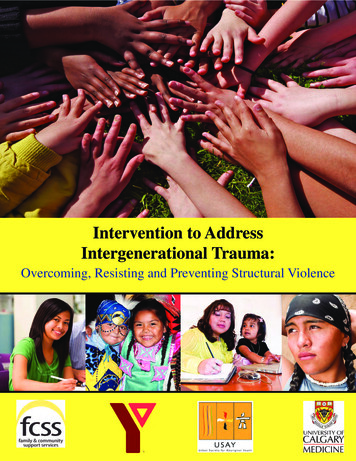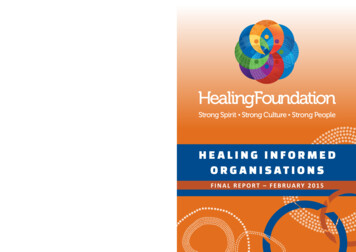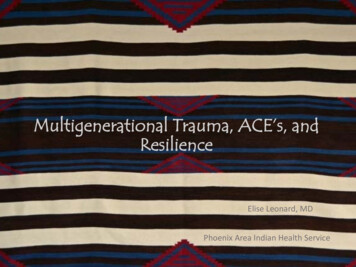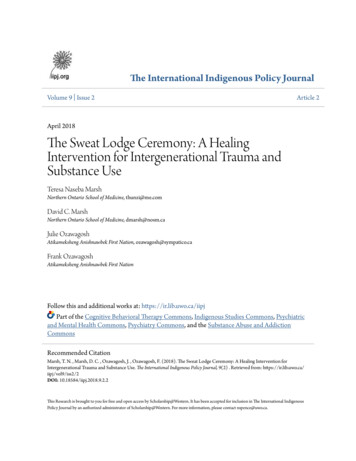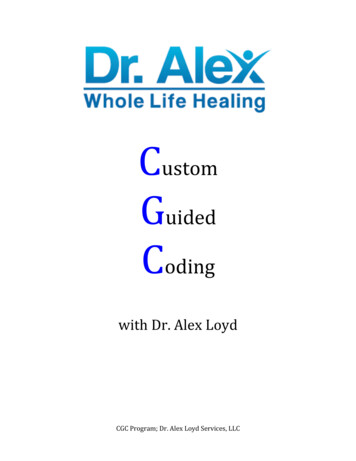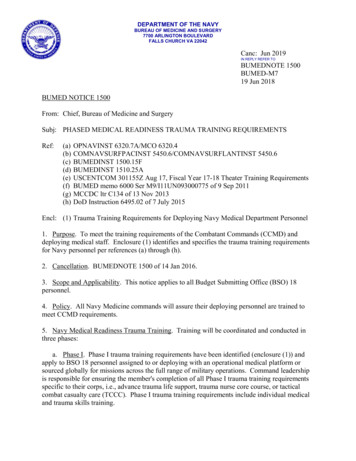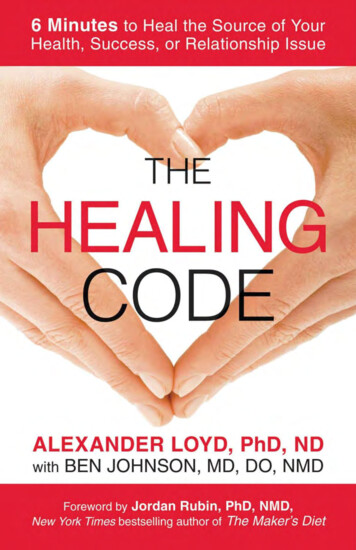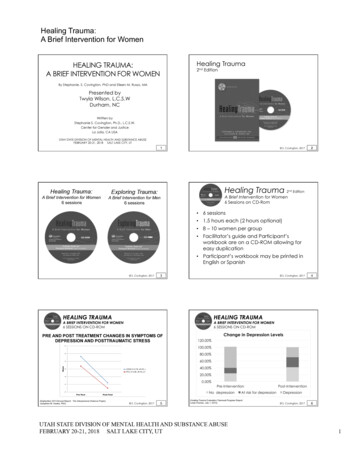
Transcription
Healing Trauma:A Brief Intervention for WomenHealing TraumaHEALING TRAUMA:A BRIEF INTERVENTION FOR WOMEN2nd EditionBy Stephanie. S. Covington, PhD and Eileen M. Russo, MAPresented byTwyla Wilson, L.C.S.WDurham, NCWritten byStephanie S. Covington, Ph.D., L.C.S.W.Center for Gender and JusticeLa Jolla, CA USAUTAH STATE DIVISION OF MENTAL HEALTH AND SUBSTANCE ABUSEFEBRUARY 20-21, 2018 SALT LAKE CITY, UT1Healing Trauma:Healing Trauma 2Exploring Trauma:A Brief Intervention for Women6 sessions S. Covington, 2017A Brief Intervention for Men6 sessionsnd2EditionA Brief Intervention for Women6 Sessions on CD-Rom 6 sessions 1.5 hours each (2 hours optional) 8 – 10 women per group Facilitator’s guide and Participant’sworkbook are on a CD-ROM allowing foreasy duplication Participant’s workbook may be printed inEnglish or Spanish S. Covington, 20173HEALING TRAUMA S. Covington, 20174 S. Covington, 20176HEALING TRAUMAA BRIEF INTERVENTION FOR WOMEN6 SESSIONS ON CD-ROMA BRIEF INTERVENTION FOR WOMEN6 SESSIONS ON CD-ROMPRE AND POST TREATMENT FigureCHANGESIN SYMPTOMS OF4Changes in Symptoms of Depression and PTSD, CWC IPV Project,DEPRESSIONAND POSTTRAUMATIC STRESSOctober 1, 2012 through September 30, 2013 (N 53)2725Score2321CESD (t 4.79, df 52, p .000)PCL (t 2.96, df 52, p .005)191715Pre-TestPost-Test(September 2013 Annual Report: The Interpersonal Violence Project,Josephine M. Hawke, PhD) S. Covington, 20175(Healing Trauma Evaluation Triannual Progress Report,Linda Frisman, July 1, 2015)UTAH STATE DIVISION OF MENTAL HEALTH AND SUBSTANCE ABUSEFEBRUARY 20-21, 2018 SALT LAKE CITY, UT1
Healing Trauma:A Brief Intervention for WomenWhat Makes a Good Facilitator? (cont.)Part 1INTRODUCTION The World Women Live InBE PREPARED! Trauma The Therapeutic Environment The Program Design of Facilitator Guide Facilitation S. Covington, 20177Role of the FacilitatorPart 2 Begin and end on timeSESSIONS S. Covington, 20178 S. Covington, 201710 Maintain structure of the group Move the group through the contents ofeach session Lead by example by having appropriateboundaries and containing your feelings Allow each woman to have her ownexperience of the group S. Covington, 2017Healing Trauma 2nd9Format All SessionsEditionA Brief Intervention for Women6 Sessions on CD-Rom Quiet time—“settling” Check-inSession 1: Welcome and IntroductionSession 2: Power and Abuse Review of between-sessions activitySession 3: The Process of Trauma and Self-Care DiscussionsSession 4: The ACE Survey and Anger LecturesSession 5: Healthy Relationships Interactive exercisesSession 6: Love, Endings, and Certificates(workbook in English and Spanish) S. Covington, 2017 Closing, grounding exercise11UTAH STATE DIVISION OF MENTAL HEALTH AND SUBSTANCE ABUSEFEBRUARY 20-21, 2018 SALT LAKE CITY, UT S. Covington, 2017122
Healing Trauma:A Brief Intervention for WomenSession 1Session 1 - Overview2 ACTIVITIESWelcome and Introduction tothe Subject of Trauma Goals: To begin to establish a groupenvironment that is based on trust,safety, and respect To provide an introduction to thesubject of trauma S. Covington, 2017Welcome, Facilitator Introductions, and Goals forthe GroupWhy We Are Here: Information about TraumaGroup AgreementsPersonal Goal Sheet (and Optional InformationSurvey)Art Activity: Decorate Your Cover/FolderParticipant IntroductionsSharing GoalsGrounding Activity: Five SensesReflection, Between-Sessions Activity, and Close13 S. Covington, 2017Session 1This Group will Help YouACTIVITIES Learn more about trauma and howwidespread it is in women’s lives Decorate Your Cover/Folder14 Become aware of the strengths you alreadyhave that can help you recover Five Senses Increase the skills you need for healing Learn exercises and techniques that canhelp you feel more grounded and safe S. Covington, 201715 S. Covington, 2017Inner Self & Outer SelfInner Self & Outer Self (cont.) Impacts Inner Self – It can impact our innerlife our thoughts, feelings, beliefs, values.For example, some women believe that“you can’t trust anyone”, and “the world isvery unsafe place.” Impacts Outer Self – It can impact our outerlife our outer life consists of ourrelationships and our behavior. Manywomen who have experienced traumastruggle with their relationships – families,friends, secual relationships. S. Covington, 201717UTAH STATE DIVISION OF MENTAL HEALTH AND SUBSTANCE ABUSEFEBRUARY 20-21, 2018 SALT LAKE CITY, UT S. Covington, 201716183
Healing Trauma:A Brief Intervention for WomenFive SensesGrounding Exercise:Five Senses S. Covington, 201719 S. Covington, 201720Session 2Reflection Page2 ACTIVITIESThis is a place where you can write or drawabout your experience in the group. Maybeyou’d like to write about what was mostmeaningful to you in Session 1.Power and AbuseGoals: To explore the effects of genderroles on individuals To emphasize the connectionbetween power and abuse To identify behavioralcharacteristics of people whoabuse others S. Covington, 201721 S. Covington, 201722Session 2Session 2 - OverviewACTIVITIES Quiet TimeCheck-InReview of Last Session and the Between-SessionsActivityTraumatic EventsGender ExpectationsThe Connection between Power and AbuseThe Power and Control WheelCharacteristics of People Who Abuse OthersSoothing VisualizationReflection, Between-Sessions Activity, and Close[Optional: Yoga Pose] S. Covington, 2017 Power and Control Wheel Soothing Visualization23UTAH STATE DIVISION OF MENTAL HEALTH AND SUBSTANCE ABUSEFEBRUARY 20-21, 2018 SALT LAKE CITY, UT S. Covington, 2017244
Healing Trauma:A Brief Intervention for WomenGender Expectations How are boys and girls treated differently aschildren?Gender Expectations:Social Messages Social messages come from familymembers, communities, teachers, movies,music, and video games. What are thesocial messages that boys get? How areboys supposed to act? What are the social messages that girls get?How are girls supposed to act? S. Covington, 201725Focus Questions S. Covington, 201726The Connection BetweenPower and Abuse How are boys and girls treated differently? What does it mean to “act like a woman”?Here are some ways in which power and abuseare connected: What does it mean to “act like a man”? The abuser uses power over the victim. What would it be like if our roles and themessages were reversed? The abuser takes power away from the victim. The victim feels powerless against the abuserand in many aspects of her life. The victim feels trapped or locked in a role. The victim feels isolated, so there is no strengthor power from others who could help. S. Covington, 201727POWER AND CONTROL WHEEL S. Covington, 201728Characteristics of BatterersBehavior as Clues: Jealousy Controlling behavior Quick involvement Unrealistic expectations Isolation Blaming others for problems Blaming others for feelings Hypersensitivity(From the manual In Our Best Interest: A Process for Personal and Social Change. Availablethrough Domestic Abuse Intervention Project, 206 W. 4th St., Duluth, MN 55806) S. Covington, 201729UTAH STATE DIVISION OF MENTAL HEALTH AND SUBSTANCE ABUSEFEBRUARY 20-21, 2018 SALT LAKE CITY, UT S. Covington, 2017305
Healing Trauma:A Brief Intervention for WomenCharacteristics of Batterers (cont.) Cruelty to animals and/or childrenGuided Imagery:Safe Place “Playful” use of force in sex Verbal abuse Rigid sex roles Dr. Jekyll and Mr. Hyde Past battering Threats of violence Hitting or breaking objects Use of force during an argument S. Covington, 201731 S. Covington, 2017Session 332Session 3 - Overview3 ACTIVITIESThe Process of Trauma and SelfCare Goals: To present the Process of Trauma To introduce a variety of groundingand self-soothing activities To explore the concept of personalboundaries S. Covington, 201733Quiet TimeCheck-InReview of Last Session and the Between-SessionsActivityThe Process of TraumaWhat Does It Mean to Feel “Grounded”?Grounding ActivitiesSelf-Soothing ChartRelaxation ActivityDeveloping Personal BoundariesReflection, Between-Sessions Activity, and Close[Optional: Yoga Pose] S. Covington, 201734Session 3ACTIVITIESPersonal Boundaries Grounding Activities Self-Soothing Chart Relaxing Activity S. Covington, 201735UTAH STATE DIVISION OF MENTAL HEALTH AND SUBSTANCE ABUSEFEBRUARY 20-21, 2018 SALT LAKE CITY, UT S. Covington, 2017366
Healing Trauma:A Brief Intervention for WomenProcess of TraumaGroundingTraumatic EventOverwhelms the physical and psychological coping skillsGrounding techniques are strategies to help aperson who is dissociating (“losing time,”emotionally absent) “come back” into currentreality and feelings.Response to TraumaFight, flight, or freezeAltered state of consciousness, Body sensations, Numbing,Hypervigilance, Hyperarousal, CollapseSensitized Nervous SystemChanges in the BrainBrain-Body ConnectionPsychological and Physical DistressCurrent stressors, Reminders of trauma (triggers)Sensations, Images, Behavior, Affect (emotions), MemoryGrounding techniques can help womenrealize that they are in the here and now andthat what they are experiencing is in the pastand it is not happening now.Emotional and/or Physical ResponsesRetreatHarmfulBehavior to SelfHarmfulBehavior to OthersPhysicalHealth IssuesIsolationDissociationDepressive disordersAnxiety disordersSubstance usedisordersFeeding and eatingdisordersDeliberate self-harmSuicidal actionsAggressionViolenceRagesThreatsLung diseaseHeart diseaseAutoimmunedisordersObesity S. Covington, 201737Grounding S. Covington, 201738Self - Soothing PhysicalAloneWith Others MentalDaytimeNight Time S. Covington, 201739Relaxation Exercise S. Covington, 2017 S. Covington, 201740Developing Boundaries41UTAH STATE DIVISION OF MENTAL HEALTH AND SUBSTANCE ABUSEFEBRUARY 20-21, 2018 SALT LAKE CITY, UT S. Covington, 2017427
Healing Trauma:A Brief Intervention for WomenSession 4Session 4 - Overview5 ACTIVITIESThe ACE Questionnaireand AngerQuiet TimeCheck-InReview of Last Session and the Between-SessionsActivityThe Adverse Childhood Experiences QuestionnaireThe ACE StudyAngerWords for AngerMeeting a FeelingThe Anger Funnel Goals: To connect the women’s childhoodtraumatic experiences to their presentbehaviors To better understand the feeling ofanger and how to manage it in healthyways To revisit the Power and Control Wheel S. Covington, 201743 S. Covington, 201744Session 4Session 4 – Overview (cont.)ACTIVITIES Activity: The Anger FunnelActivity: Anger TriggersActivity: Palms Down, Palms UpReflection, Between-Sessions Activity, and Close Adverse Childhood ExperiencesQuestionnaire Meeting a Feeling Anger Funnel Anger Triggers Palms Down, Palms Up S. Covington, 201745 S. Covington, 2017ACE StudyACE Study (cont.)Before age 18:Growing up in a household with1.Recurrent and severe emotional abuse2.Recurrent and severe physical abuse3.Contact sexual abuse4.Emotional neglect5.Physical neglect6.Both biological parents not being present7.Your mother being treated violently8.An alcoholic or drug user9.A family member who is mentally ill,chronically depressed, or attempting suicide4610. A family member being imprisoned(N 17,000) S. Covington, 201747UTAH STATE DIVISION OF MENTAL HEALTH AND SUBSTANCE ABUSEFEBRUARY 20-21, 2018 SALT LAKE CITY, UT S. Covington, 2017488
Healing Trauma:A Brief Intervention for WomenAdverse Childhood ExperiencesSEEDS(www.cdc.gov/ace)S – Social Connectivity(www.ACEStudy.org)Being in connection and relationship with othersDeathE – ExerciseWhole Life PerspectiveThirty minutes a day can make a big differenceConceptionE – EducationLearn something new each dayD – DietThe food we eat either nourishes or starves our brainS – SleepOur brains and our bodies need to rest andregenerate each dayMechanisms by Which Adverse Childhood Experiencesinfluence Health and Well-being Through the Lifespan.(R. Fallot, Ph.D.) S. Covington, 201749(Arden 2014) S. Covington, 201750ANGER WORDS The Anger Cycle S. Covington, EXASPERATION51 ALOUSLYMEAN-SPIRITEDOUTRAGERAGERESENTMENTSPITE S. Covington, 201752Anger FunnelHurtSadnessFearInsecurityMeeting a FeelingAngerRageViolence S. Covington, 201753UTAH STATE DIVISION OF MENTAL HEALTH AND SUBSTANCE ABUSEFEBRUARY 20-21, 2018 SALT LAKE CITY, UT S. Covington, 2017549
Healing Trauma:A Brief Intervention for WomenAnger TriggersPalms Down, Palms Up S. Covington, 201755 S. Covington, 2017Session 556Session 5 - Overview1 ACTIVITYHealthy Relationships Goals: To describe the elements of ahealthy relationship To introduce the Wheel of Love S. Covington, 2017Quiet TimeCheck-InReview of Last Session and the Between-SessionsActivityThe Brain and RelationshipsDefining a Healthy Relationship and theRelationship WheelAspects of a Healthy RelationshipThe Relationship Wheel and the Power and ControlWheel57 S. Covington, 201758Session 5Session 5 – Overview (cont.)ACTIVITY Activity: The Relationship WheelWhat Is Love?Grounding Activity [Optional: Yoga Pose]Reflection, Between-Sessions Activity, and Close S. Covington, 2017 Relationship Wheel59UTAH STATE DIVISION OF MENTAL HEALTH AND SUBSTANCE ABUSEFEBRUARY 20-21, 2018 SALT LAKE CITY, UT S. Covington, 20176010
Healing Trauma:A Brief Intervention for WomenRelationship WheelRespect, Mutuality, CompassionRespectRespect is the appreciation of someone’svalues and it begins to happen when we seetheir integrity. We often earn respect when weare willing to do the right thing or take the“right action,” particularly when the choice isdifficult. S. Covington, 201761 S. Covington, 2017Respect, Mutuality, CompassionRespect, Mutuality, CompassionMutualityCompassionMutuality means there is an equal investmentin the relationship. Each person has awillingness and desire to see the other, as wellas being seen; to hear the other, as well asbeing heard; and to be vulnerable, as well asrespecting the other’s vulnerability. Mutualityalso means that there is an awareness of the“we,” not a sole focus on two “I”’s.Compassion is similar to empathy but it occurson a deeper level. Empathy is understandinganother’s feeling and being able to feel withthem. Compassion means that we go a stepfurther and join with them in their struggle orpain. When we are compassionate we lendour selves to another’s process – we give ofourselves in order to be with them emotionally. S. Covington, 201763Aspects of a Healthy Relationship 62 S. Covington, 201764 S. Covington, 201766Wheel of LoveSimilaritiesAbility to Deal with ChangeCompatible ValuesEffective, Open CommunicationEffective Conflict/Anger ResolutionEffective NegotiationFirm Personal BoundariesHealthy Sexual ExpressionShared Quality TimeFriendship S. Covington, 201765UTAH STATE DIVISION OF MENTAL HEALTH AND SUBSTANCE ABUSEFEBRUARY 20-21, 2018 SALT LAKE CITY, UT11
Healing Trauma:A Brief Intervention for WomenRelationship ScaleRelationship Scale (cont.)1. Similarities12346. Effective Negotiation567891012. Compatible Values1234567891013. Ability to Deal with 456789109. Shared Quality Time91015. Effective Conflict Resolution138. Healthy Sexual Expression104. Clear Communication127. Firm Personal Boundaries92345678910567891010. Friendship101 S. Covington, 201723467 S. Covington, 2017Session 668Session 6 - Overview2 ACTIVITIESLove, Endings, and Certificates Goals: To help women understand whatthey bring to relationships To use creative arts to enable eachwoman to depict her history of loveand how she would like toexperience love in the future To explore how to end relationshipsrespectfullyQuiet TimeCheck-InReview of Last Session and the Between-SessionsActivityBringing Ourselves to RelationshipsLove Collage and Sharing ActivityHow to End a RelationshipAppreciation ActivityThe Spiral of Trauma and HealingGoal Sheets and Evaluations [Optional: InformationSurvey 2]Certificates of Completion To show appreciation for the groupmembers and the group experience Session 6Bringing Ourselves to RelationshipsACTIVITIES Do you remember what you were likebefore the abuse? S. Covington, 201769 Love Collage S. Covington, 201770 Do you want to find that person again? Appreciation If so, what qualities do you need to find ordevelop in yourself? If not, what kind of person do you want tobe? What qualities do you need to find ordevelop in yourself? What makes you feel safe? S. Covington, 201771UTAH STATE DIVISION OF MENTAL HEALTH AND SUBSTANCE ABUSEFEBRUARY 20-21, 2018 SALT LAKE CITY, UT S. Covington, 20177212
Healing Trauma:A Brief Intervention for WomenBringing Ourselves to Relationships (cont.) What brings you joy?Art Activity: What kinds of relationships do you want tohave with others from now on?Love Collage What do you want to offer or give in thoserelationships? How do you want to be and feel in yourrelationships? What qualities do you bring to relationships? S. Covington, 201773How To End a Relationship Find a safe place where you are not aloneif someone has abused you. Be direct and honest. Speak using “I” statements rather than“you” statements. Express the feelings you are experiencing inthe present. Assume personal responsibility for change. Decide on the level of intimacy or contactS. Covington, 2017you want with the person in the future. S. Covington, 2017How To End a RelationshipAppreciation(cont.) Act in a timely fashion. Establish and stickto agreed-on timelines by which changesshould occur. Let the other person know what youappreciate about her or him. Let the other person know what youappreciate about the relationship. Tell the other person what you wish you’dbeen able to do differently.7574 S. Covington, 201776Transformation What I appreciate about the other womenin the group What I appreciate about the groupTrauma(constriction) S. Covington, 201777UTAH STATE DIVISION OF MENTAL HEALTH AND SUBSTANCE ABUSEFEBRUARY 20-21, 2018 SALT LAKE CITY, UTHealing(expansion) S. Covington, 20177813
Healing Trauma:A Brief Intervention for WomenFOR MORE INFORMATIONTwyla P Wilson, LCSWWith each ending,space is created for newbeginnings.Email: twyla.lcsw@gmail.comWebsites: gytoday.com/rms/105193112 Swift AvenueDurham, NC 27705919-801-9087Stephanie S Covington, Ph.D., LCSWEmail: sc@stephaniecovington.comWebsites: g S. Covington, 201779UTAH STATE DIVISION OF MENTAL HEALTH AND SUBSTANCE ABUSEFEBRUARY 20-21, 2018 SALT LAKE CITY, UT S. Covington, 20178014
HEALING TRAUMA A BRIEF INTERVENTION FOR WOMEN 6 SESSIONS ON CD-ROM 15 17 19 21 23 25 27 Pre-Test Post-Test Score Figure 4 Changes in Symptoms of Depression and PTSD, CWC IPV Project, October 1, 2012 through September 30, 2013 (N 53) CESD (t 4.79, df 52, p .000) PCL (t 2.96, df 52, p .005) PRE AND POST TREATMENT CHANGES IN SYMPTOMS OF
